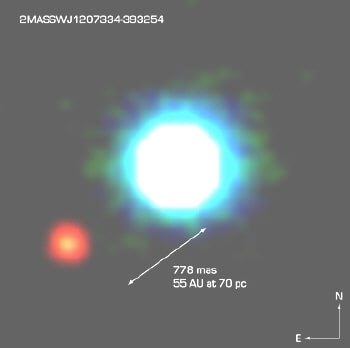Astronomers may have taken the first ever photograph of a planetary system outside our own solar system. Gael Chauvin of the European Southern Observatory (ESO) and colleagues in Chile, Germany, France and the US have taken images of what appears to be a planet orbiting a young brown dwarf about 230 light years away. The results could shed more light on how planetary systems form (Astronomy & Astrophysics in press).

Chauvin and colleagues made the discovery in April with the 8.2-metre Yepun telescope, which is part of ESO’s Very Large Telescope array at the Paranal Observatory in Chile. By exploiting “adaptive optics” to correct for atmospheric blurring, the team was able to obtain extremely sharp near-infrared images of a faint object lying close to a brown dwarf known as 2M1207. A brown dwarf is a failed star that is too small to generate energy using nuclear processes.
According to the team, measurements of the infrared spectrum of the companion object confirm that it has a mass of just five times that of Jupiter and lies about 55 Earth-Sun distances from its host. 2M1207 itself is 25 times heavier than Jupiter or, equivalently, about 42 times less massive than the Sun.
The system is part of the TW Hydrae Association, which is believed to be only around eight million years old. It is therefore young enough to study how planetary systems form and evolve. In contrast, our solar system is 4.6 billion years old.
Chauvin’s team now plan to make more detailed observations to confirm whether the object is indeed a planet in orbit around 2M1207. “Our discovery represents a first step towards opening a new field in astrophysics: the imaging and spectroscopic study of planetary systems,” says team member Anne-Marie Lagrange from the Grenoble Observatory in France. “Such studies will enable astronomers to characterise the physical structure and chemical composition of giant and, eventually, terrestrial-like planets.”



